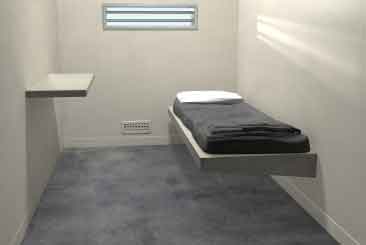|
|
| Using Restrictive Housing to Manage Gangs in US prisons |
| By David C. Pyrooz, Ph.D., NIJ "News & Views" |
| Published: 12/03/2018 |
 Author’s Note: Findings and conclusions reported in this article are those of
the author and do not necessarily represent
the official position or policies of the U.S. Department of Justice.
Author’s Note: Findings and conclusions reported in this article are those of
the author and do not necessarily represent
the official position or policies of the U.S. Department of Justice.
Gangs remain one of the more formidable issues that corrections officials face in managing prisons. About 200,000 of the 1.5 million U.S. inmates are affiliated with gangs, and there is no sign that prison gang activity is abating [1]. Gangs are responsible for a disproportionate amount of prison misconduct and violence, and their presence and actions challenge ongoing efforts to maintain control, order and safety in prisons [2]. Numerous responses to combat gangs have been implemented throughout U.S. prison systems, but only one has been described as a “silver bullet:” removing gang affiliates from the general population and placing them in restrictive housing [3]. This practice started in large prison systems (e.g., California, Texas) to constrain gang influence and violence, and expanded to other prison systems with the proliferation of prison gangs since the 1980s. Moreover, the use of restrictive housing to manage gangs is considered one of the most controversial correctional practices because it places gang affiliates in restrictive housing, not because they have earned it (e.g., being disciplined for rule violations) or needed it (e.g., protection from self or others), but for the purpose of managing the threat they may pose to the institution. It is not uncommon to observe the wholesale placement of entire gangs or all gang affiliates in restrictive housing for indeterminate periods [4]. The Pelican Bay hunger strikes, along with the Ashker v. Governor of California class-action lawsuit in 2012 and settlement in 2015, brought considerable attention to the condition of gang affiliates in restrictive housing [5]. This article summarizes key findings from Chapter 4, “Gang Affiliation and Restrictive Housing in U.S. Prisons,” which examines gang affiliation and the use of restrictive housing in the National Institute of Justice published volume, Restrictive Housing in the United States: Issues, Challenges, and Future Directions. More details of the reviewed studies and their findings can be found in the full volume [6]. Why place gang affiliates in restrictive housing? Gang affiliates fit squarely into the logic underlying the use of restrictive housing [7]. Gang affiliates commit both violent and nonviolent misconduct at higher rates than inmates not affiliated with gangs [8]. Removing them from the general population is expected to deter both misbehaving inmates and the prison population at large from disruptive behavior, incapacitate highly-disruptive inmates, normalize prisons and soothe tensions. Corrections officials have, overwhelmingly, endorsed the use of restrictive housing for gang affiliates. Between 55 and 67 percent of jails, prisons or prison systems use restrictive housing as a response to gangs [9]. Nearly half of the 600 prison wardens surveyed by Dan Mears and his colleagues at the Urban Institute agreed that gang affiliates should be placed in restrictive housing; 83 percent endorsed its use for gang leaders [10]. Of the 37 gang-knowledgeable personnel in respective prison systems surveyed by John Winterdyk and Rick Ruddell, nearly all (94 percent) reported that restrictive housing was a “very effective” (75 percent) or “somewhat effective” (19 percent) method to combat gangs [11]. Does the widespread use of restrictive housing result in an over-representation of gang affiliates in prisons? Thus far, the best evidence indicates this may be true. However, our understanding of this relationship is limited to only a few states. Administrative data from prison systems in California, Colorado and Texas show that gang affiliates were overrepresented in restrictive housing [12]. Despite constituting a minority of the custodial population in these states, the majority of inmates in restrictive housing were gang affiliates, who were between 6 and 71 times more likely to be placed in restrictive housing than inmates who were not. Click here to view the full report. David C. Pyrooz, Ph.D. is Assistant Professor of Sociology at the University of Colorado Boulder. He is also a faculty associate in the Problem Behavior and Positive Youth Development Program in the Institute of Behavioral Science |
Comments:
Login to let us know what you think
MARKETPLACE search vendors | advanced search

IN CASE YOU MISSED IT
|


http://www.xn--277c.com/14677 http://freest.at/67286 http://webhop.se/16146 http://www.short4free.us/89763 http://ralive.de/98668 https://atho.me/3SNw http://www.abcagency.se/38101 http://corta.co/54123 http://freest.at/85192 https://aaa.moda/65240 http://tans.me/56008 http://ralive.de/34389 http://awalsh.com/47070 http://rih.co/17148 http://goto.iamaws.com/29365 http://freest.at/86217 https://xxs.yt/14623 https://arill.us/22873 http://www.lookweb.it/36967 https://xxs.yt/19782 http://www.short4free.us/21636 http://tans.me/29479 http://tropaadet.dk/54368 http://999.sh/61114 https://lil.ink/89588 http://www.lookweb.it/78468 https://xxs.yt/96641 http://ralive.de/76792 http://awalsh.com/34987 http://ralive.de/16973 http://www.xn--277c.com/93202 http://yourls.site/27846 https://xxs.yt/70882 http://webhop.se/27846 http://www.lookweb.it/30506 http://www.abcagency.se/68091 https://lil.ink/58282 http://goto.iamaws.com/96384 https://aaa.moda/88920 http://www.short4free.us/95467 https://aaa.moda/50779 https://arill.us/25092 https://aaa.moda/84719 http://www.short4free.us/95744 http://go.fireontherim.com/63322 http://www.short4free.us/80506 http://c.or.at/53349 http://goto.iamaws.com/44204 http://corta.co/95271 http://www.abcagency.se/96830 https://aaa.moda/32814 http://ralive.de/55530 http://yourls.site/25066 https://e13.co/86257 http://tans.me/26962 https://e13.co/20992 http://c.or.at/29697 https://aaa.moda/76205 http://www.xn--277c.com/50466 https://aaa.moda/54161 http://goto.iamaws.com/29913 http://ralive.de/61921 https://aaa.moda/18025 http://valeriemace.co.uk/98179 http://ralive.de/42600 http://www.short4free.us/80367 http://www.abcagency.se/42018 http://wntdco.mx/58373 http://valeriemace.co.uk/49098 http://www.lookweb.it/82509 http://perkele.ovh/78269 https://xxs.yt/38265 http://ralive.de/46068 http://corta.co/69040 http://go.fireontherim.com/76052 https://tinyurl.com/y762h3ux http://goto.iamaws.com/85336 http://freest.at/66557 http://ralive.de/16293 http://freest.at/51290 http://valeriemace.co.uk/51699 https://aaa.moda/22038 http://www.vkvi.net/17070 https://xxs.yt/85188 https://atho.me/3SNX https://xxs.yt/49591 http://go.fireontherim.com/25227 http://c.or.at/99122 http://tropaadet.dk/37147 http://www.short4free.us/17385 http://perkele.ovh/31704 http://www.short4free.us/28235 http://corta.co/35995 http://ralive.de/84546 https://lil.ink/63930 http://webhop.se/41017 http://valeriemace.co.uk/62303 http://www.short4free.us/99186 http://webhop.se/28268 http://c.or.at/49852
I agree with you that this concept is really great and I also read your old project which was also very useful in find file explorer windows 10. Good custom type of data which is usefully good.